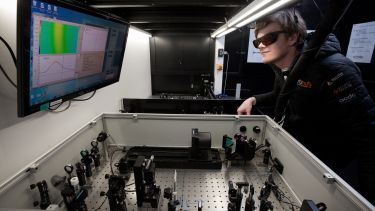Equipment
World-leading research is being performed at the Lord Porter Ultrafast Laser Spectroscopy Laboratory, assisted by the 10-KHz laser system, which allows for quicker data acquisition.

The facility provides an environment where the same sample can be studied across a multitude of timescales, from tens of femtoseconds to milliseconds..
Researchers can also study solution phase samples, thin films and solids. Variable temperature measurements can be taken with and without a weak <1T magnetic field.
We use three main detection methods:
Transient absorption spectroscopy
Transient absorption (TA) is the study of ultrafast processes in the UV-Vis spectral region. It allows us to easily follow electronic transitions such as metal-to-ligand charge transfer.
TA is used in our chemistry research for the study of chromophores, such as porphyrins in Dr Adrien Chauvet's group, and for the study of donor-bridge acceptor complexes in Professor Julia Weinstein's group. Our physics researchers use TA for the study of advanced photophysical processes, such as triplet-triplet annihilation.
Time resolved infra-red spectroscopy
Time resolved infra-red spectroscopy (TRIR) allows us to follow changes in the vibrational spectra of excited molecules over time. This is incredibly useful as many compounds contain functional groups that strongly absorb IR, such as carbonyl groups.
This technique has been used in our chemistry research for the study of electron transfer across alkyne bridges in the Weinstein group, as well as the study of mechanisms of photochemical reactions in Dr Peter Portius' group.
We can also run sophisticated IR experiments with more than two laser pulses, such as transient two-dimensional IR spectroscopy.
Fluorescence upconversion spectroscopy
Unlike the other experiments in the laser lab, fluorescence upconversion spectroscopy (FLUPS) does not study a compound’s absorption of light. Instead we collect the light emitted from the excited state, and observe how this emission changes in intensity and wavelength over time.
FLUPS is used by researchers in Professor Julia Weinstein's group to study emissive platinum complexes and answer fundamental questions about their electron transfer processes.
Our lab also includes spectrophotometry, spectrofluorimetry, fourier-transform infrared spectroscopy and a Schlenk line with diffusion pump.



